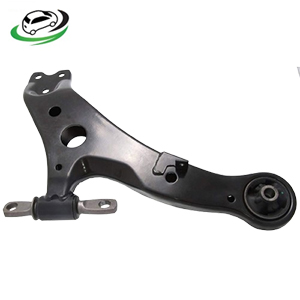Get Toyota Harrier/Lexus RX300 RX350 Front Lower Arm Assy LH
The front lower arm assembly, also known as the control arm or wishbone, is a critical component of a vehicle’s suspension system, particularly in independent front suspension setups. Its primary function is to connect the front wheel hub to the chassis or subframe while allowing for controlled movement of the wheel assembly in response to road irregularities and steering inputs.
Benefits:
1. Structural Support:
- Supports Vehicle Weight: The front lower arm assembly supports the weight of the vehicle and helps distribute it evenly across the suspension system, ensuring proper weight balance and stability.
2. Suspension Functionality:
- Controls Wheel Movement: It plays a key role in controlling the up-and-down movement of the front wheels, allowing them to move vertically in response to road irregularities while maintaining stability.
- Aids in Wheel Alignment: The geometry of the control arm helps maintain proper wheel alignment, ensuring even tire wear and optimal handling characteristics.
3. Stability and Handling:
- Reduces Body Roll: By connecting the front wheel hub to the chassis, the control arm helps minimize body roll during cornering, enhancing vehicle stability and handling.
- Improves Steering Response: The stability provided by the control arm contributes to more precise steering response, allowing for better control and maneuverability.
4. Comfort and Ride Quality:
- Absorbs Road Impacts: The control arm, along with other suspension components, absorbs shocks and vibrations from the road surface, providing a smoother and more comfortable ride for passengers.
- Minimizes Noise and Vibration: It helps dampen noise and vibrations transmitted from the wheels and suspension to the vehicle’s cabin, reducing driver and passenger discomfort.
5. Safety:
- Enhances Brake Performance: Proper suspension geometry maintained by the control arm contributes to optimal brake performance, ensuring effective braking and stopping distances.
- Maintains Tire Contact: By keeping the front wheels firmly planted on the road surface, the control arm helps maintain tire contact, improving traction and stability, especially during braking and cornering maneuvers.
6. Longevity and Durability:
- Constructed from Robust Materials: Control arms are typically made from durable materials such as steel or aluminum, providing strength and resistance to wear and tear.
- Minimizes Component Wear: By distributing forces evenly across the suspension system, the control arm helps minimize wear on other components, prolonging their lifespan and reducing maintenance costs.
Signs a car needs a new Front Lower Arm Assy LH;
1. Steering and Handling Issues:
- Pulling or Drifting: If the vehicle pulls to one side or experiences drifting while driving, it could be a sign of a worn or damaged front lower arm assembly.
- Vibration in Steering Wheel: Excessive vibration felt in the steering wheel, especially during acceleration or braking, may indicate problems with the front suspension, including the lower arm assembly.
2. Uneven Tire Wear:
- Inner or Outer Tire Wear: Worn or damaged front lower arm assemblies can cause uneven tire wear, particularly on the inner or outer edges of the tires. Inspect the tires for signs of abnormal wear patterns.
3. Noises from the Suspension:
- Clunking or Knocking Noises: A clunking or knocking noise coming from the front suspension, especially when driving over bumps or rough roads, can be a sign of worn ball joints or bushings in the lower arm assembly.
4. Steering Instability:
- Loose or Unstable Steering: A feeling of looseness or instability in the steering, especially when cornering or driving at high speeds, may indicate a problem with the front lower arm assembly.
5. Visual Inspection:
- Visible Damage or Corrosion: Inspect the front lower arm assembly for signs of damage, such as cracks, bends, or corrosion. Any visible damage indicates the need for replacement.
- Leaking Bushings: If the bushings on the lower arm assembly appear to be leaking fluid or are cracked, they may need to be replaced.
6. Suspension Sag or Ride Height Changes:
- Uneven Ride Height: A noticeable sagging or change in ride height on one side of the vehicle, especially when compared to the other side, may indicate a problem with the front lower arm assembly.
Follow us on Facebook for more parts.



